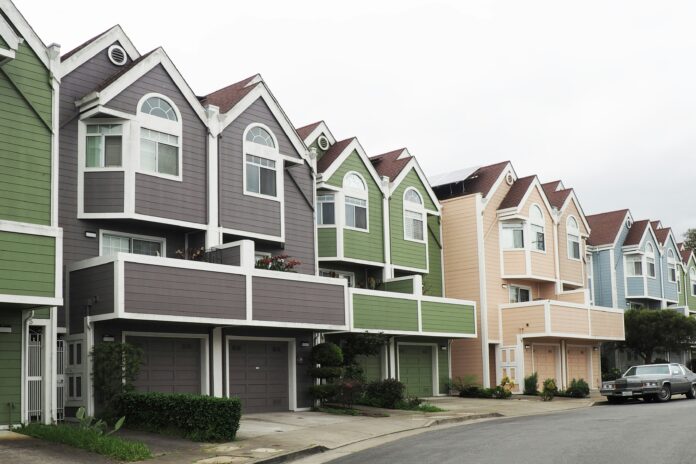Texas’s housing landscape has taken a surprising turn as supply levels in some of its major cities have reached heights unseen since 2017. With active listings soaring by 25% year-over-year and an eye-popping 263% from pandemic lows, the state has transitioned from a housing shortage to an oversupply situation. This shift, driven by a wave of investor and builder sell-offs, has left some of Texas’s largest markets grappling with an abundance of available homes.
At the forefront of this change is Austin, where listings have surged by 42%, creating a surplus that is impacting both new and resale properties. Dallas and San Antonio follow closely with 39% and 38% inventory surpluses, respectively. In these cities, thousands of homes now sit on the market, with prices cooling off and buyers holding off on major purchases, a far cry from the feverish buying frenzy of recent years.
What’s behind this shift? The answer seems to lie in several converging factors. During the pandemic, Texas attracted a wave of investors and builders eager to capitalise on the booming market, but they now face rising property taxes, slow rent growth, and pressure to cut prices. Some investors, especially those who rushed into the market hoping to turn quick profits, are finding that high taxes and stagnant rent prices are taking a toll on cash flow. For many, this combination is making it increasingly difficult to keep holding on to properties, prompting them to list at discounted prices, further fuelling the glut of homes available.
Austin, once the state’s booming tech hub and an area where housing prices skyrocketed amid high demand, has emerged as ground zero for the housing downturn. Home values there have dropped by nearly 20% from their peak, creating unease among homeowners and investors alike. Today, Austin has over 10,000 active listings, a massive increase compared to pre-pandemic levels when the number hovered around 7,000. This situation has not only reshaped Austin’s property market but has also raised concerns among those who anticipated the city would sustain its rapid growth.
Dallas-Fort Worth (DFW) is experiencing a similar situation. The region, home to around 26,000 listings, hasn’t seen such high levels of supply since 2017. While values haven’t taken as dramatic a hit as in Austin, they’re still down by 3–5% from their peak, varying by neighbourhood. The influx of inventory has left local agents scrambling to adapt their sales tactics, with some reporting a noticeable shift in buyers’ expectations as they sense that the once red-hot market has cooled off. Homeowners who bought at the height of the market are now faced with a choice: ride out the slowdown or cut their losses, with many choosing the latter option.
Meanwhile, San Antonio has become yet another hotspot for Texas’s housing supply boom. With its 38% inventory surplus, the city is witnessing a similar situation as Dallas, with new listings piling up and prices softening. The affordability that once made San Antonio attractive to buyers now seems threatened as the overabundance of properties shifts the balance of power away from sellers.
Much of the current market glut is attributed to the building boom that swept across Texas in recent years. In response to high demand and short supply during the pandemic, developers ramped up construction, particularly in cities like Austin and Dallas. But as mortgage rates climbed and demand waned, the influx of new homes flooded the market, leaving builders with excess stock. Now, facing mounting pressure to reduce inventory, some builders have started offering substantial markdowns to move properties, directly impacting the resale market and sparking concern about how long the market can sustain itself under these conditions.
The factors affecting Texas’s housing supply are numerous and intertwined. Rising property taxes in Texas have made it harder for investors to realise significant returns, especially as rents haven’t kept pace. Unlike some other states, Texas relies heavily on property taxes to fund public services, which can lead to significant expenses for homeowners and investors alike. The reality is that, in many cases, the high property tax burden has made holding onto investments less profitable, leading investors to reconsider their positions. For some, the solution has been to sell properties rather than risk an uncertain future in a high-cost environment.
Adding to this strain, rental growth has been slower than anticipated. With rents no longer rising at the speed they once did, investors find themselves squeezed between the rising costs of ownership and a lack of significant rental income. For buyers hoping to benefit from the oversupply, these factors have created a unique window of opportunity. Those in a position to buy may now find themselves with more options, and perhaps even leverage to negotiate lower prices.
The cooling of Texas’s housing market isn’t just a concern for homeowners and investors but has implications for the broader economy. The state’s real estate market has been one of the engines of its economic growth, fuelled by the influx of out-of-state residents and companies. But with the current glut of homes, some of that momentum may wane. Potential buyers are becoming more cautious, and some are choosing to wait in hopes that prices might drop further. The reluctance to buy at current prices is pushing developers and agents alike to reassess their strategies. For many, the key question now is whether the state can rebalance its housing market or if it will continue to see prices drop in the face of oversupply.
There are signals that some stabilisation may be on the horizon. With high interest rates keeping some potential buyers on the sidelines, the market might not experience the frenzied pace of earlier years, but it may gradually find equilibrium as some of the excess inventory is absorbed. However, the sheer scale of listings in cities like Austin and Dallas suggests that any recovery may take longer than hoped.
The change in Texas’s housing market has undoubtedly taken many by surprise, especially after years of sharp price increases and fierce competition for homes. The dramatic rise in listings has reset expectations for what was once seen as a nearly unshakable market. For buyers, the current market presents a range of choices, but there’s also the risk that further declines in value could occur if the oversupply persists.
In an environment shaped by shifting demand, economic pressures, and investor activity, Texas’s housing market reflects both the promise and the peril of rapid growth. As the state’s property market adapts to this new reality, a clearer picture of what’s next may emerge. But for now, with an abundance of homes on the market and prices dipping, Texas is navigating an uncharted phase in its housing history.


